英语反意疑问句
- 格式:doc
- 大小:51.00 KB
- 文档页数:18

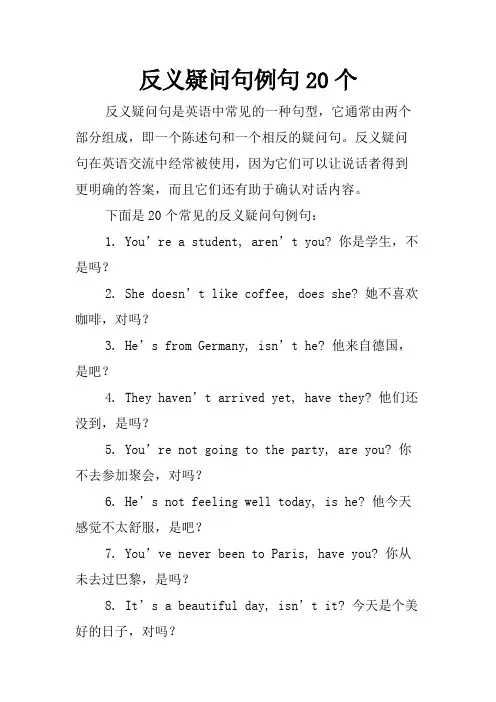
反义疑问句例句20个反义疑问句是英语中常见的一种句型,它通常由两个部分组成,即一个陈述句和一个相反的疑问句。
反义疑问句在英语交流中经常被使用,因为它们可以让说话者得到更明确的答案,而且它们还有助于确认对话内容。
下面是20个常见的反义疑问句例句:1. You’re a student, aren’t you? 你是学生,不是吗?2. She doesn’t like coffee, does she? 她不喜欢咖啡,对吗?3. He’s from Germany, isn’t he? 他来自德国,是吧?4. They haven’t arrived yet, have they? 他们还没到,是吗?5. You’re not going to the party, are you? 你不去参加聚会,对吗?6. He’s not feeling well today, is he? 他今天感觉不太舒服,是吧?7. You’ve never been to Paris, have you? 你从未去过巴黎,是吗?8. It’s a beautiful day, isn’t it? 今天是个美好的日子,对吗?9. He can’t swim, can he? 他不会游泳,对吗?10. She doesn’t like pizza, does she? 她不喜欢披萨,对吗?11. You’re not afraid of heights, are you? 你不怕高,对吗?12. They won’t be able to attend the meeting, will they? 他们不能参加会议,对吗?13. They’re leaving tomorrow, aren’t they? 他们明天要走了,对吗?14. He’s never been skiing, has he? 他从未滑过雪,对吗?15. She’s not going to the concert, is she? 她不去音乐会,对吗?16. You’re not worried about the exam, are you? 你不担心考试吧,对吗?17. He didn’t eat breakfast this morning, did he? 他今天早上没吃早餐,对吗?18. They’r e not going to the beach, are they? 他们不去海边,对吗?19. You’ve already seen the movie, haven’t you? 你已经看过这部电影了,对吗?20. He’s not coming to the party, is he? 他不来参加聚会,对吗?在使用反义疑问句时,需要注意的是,它们并不总是表示对话者的不确定或疑虑。
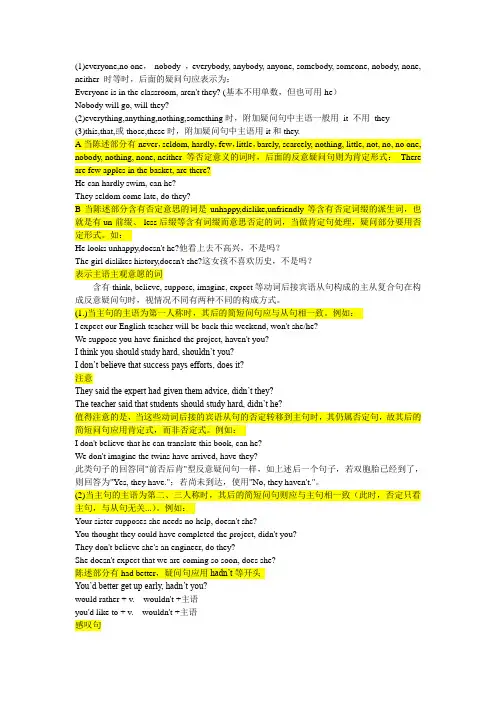
(1)everyone,no one,nobody ,everybody, anybody, anyone, somebody, someone, nobody, none, neither 时等时,后面的疑问句应表示为:Everyone is in the classroom, aren't they? (基本不用单数,但也可用he)Nobody will go, will they?(2)everything,anything,nothing,something时,附加疑问句中主语一般用it 不用they(3)this,that,或those,these时,附加疑问句中主语用it和they.A当陈述部分有never,seldom, hardly,few,little,barely, scarcely, nothing, little, not, no, no one, nobody, nothing, none, neither 等否定意义的词时,后面的反意疑问句则为肯定形式:There are few apples in the basket, are there?He can hardly swim, can he?They seldom come late, do they?B当陈述部分含有否定意思的词是unhappy,dislike,unfriendly等含有否定词缀的派生词,也就是有un-前缀、-less后缀等含有词缀而意思否定的词,当做肯定句处理,疑问部分要用否定形式。
如:He looks unhappy,doesn't he?他看上去不高兴,不是吗?The girl dislikes history,doesn't she?这女孩不喜欢历史,不是吗?表示主语主观意愿的词含有think, believe, suppose, imagine, expect等动词后接宾语从句构成的主从复合句在构成反意疑问句时,视情况不同有两种不同的构成方式。
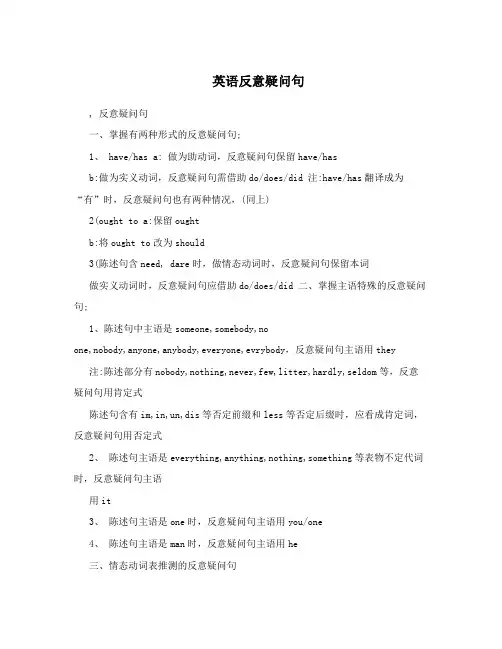
英语反意疑问句, 反意疑问句一、掌握有两种形式的反意疑问句;1、 have/has a: 做为助动词,反意疑问句保留have/hasb:做为实义动词,反意疑问句需借助do/does/did 注:have/has翻译成为“有”时,反意疑问句也有两种情况,(同上)2(ought to a:保留oughtb:将ought to改为should3(陈述句含need, dare时,做情态动词时,反意疑问句保留本词做实义动词时,反意疑问句应借助do/does/did 二、掌握主语特殊的反意疑问句;1、陈述句中主语是someone,somebody,noone,nobody,anyone,anybody,everyone,evrybody,反意疑问句主语用they 注:陈述部分有nobody,nothing,never,few,litter,hardly,seldom等,反意疑问句用肯定式陈述句含有im,in,un,dis等否定前缀和less等否定后缀时,应看成肯定词,反意疑问句用否定式2、陈述句主语是everything,anything,nothing,something等表物不定代词时,反意疑问句主语用it3、陈述句主语是one时,反意疑问句主语用you/one4、陈述句主语是man时,反意疑问句主语用he三、情态动词表推测的反意疑问句1、must,may只用于肯定句的推测,might表委婉语气2、can用于疑问句的推测3、can’t用于否定句的推测表推测时,反意疑问句不能用本词,应与后面的实义动词保持一致,时态应注意三点: 1) may/must/can’t+do:表示对现在情况进行推测,反意疑问句用一般现在时 2) may/must/can’t+have done+时间状语:表示对过去情况进行推测,反意疑问句用一般过去式时3) may/must/can’t+have done:用于现在完成时表推测,反意疑问句用现在完成时四、陈述句主谓结构特殊的反意疑问句1、陈述句主谓结构是I’m…..,反意疑问句用aren’t,否定的一般疑问句也是如此2、陈述句主谓结构是I/We think/believe/suppose/imagine/expect+从句,反意疑问句应和从句保持一致,疑问部分用肯定式或否定式应根据主句进行调节注:1)当主句为否定式时,它只构成形式否定,意义否定应在从句,因此反意疑问句应用肯定式2)如果主语是其他人称,仍以主句为根据3)在I am sure +that从句中,情况也一样3、陈述部分是主从复合句,疑问部分的谓语应该与主句的谓语保持一致五、陈述句为感叹句时,反意疑问句要用be的一般现在时,一律用否定式六、祈使句的肯定句,疑问的部分可以是肯定式或否定式祈使句的否定句,疑问的部分只能用肯定式即构成反意疑问句一律都可以用will youEg: Don’t go there will you?Help me to do it will you?七、陈述部分有use to(do) 时,疑问部分可以用didn’t/use not八、陈述部分是并列句,疑问部分的主语一般与最接近的分句的主语保持一致九、there引导的陈述句,疑问的主语仍用there在树自身的东西,用on树以外的东西,用in注:位于句首以加强语气的there引导的陈述句,疑问部分的主语由该句的主语来决定十、强调句或类似强调句的反意疑问句,一律和句首的It is/was保持一致强调句:It is/w as……that….类似强调句:It is said that…..十一、陈述句含约定俗成特殊短语的反意疑问句,反意疑问句保留第一个词Had better (not) do would rather (do) would like to doeg: You had better not be late next time., 强调句英语表示强调,往往通过单词,词组或某些结构来实现一、用单词或词组表示强调1、very(正是,就是)just(正好,恰好)right(恰当,适当)2、even, still, much, a little, a lot, a few, any, a great deal,far 等来强调形容词或副词的比较级、用do/does/did强调谓语动词,表示“真的,实在或确实” 3二、用强调句型表示强调用It is/was…..that/who/whom……来强调句子某一成分,通常被强调的部分是句中的主语,宾语或状语,it在句中无实义,只起到引起被强调部分的作用,被强调部分是以人做主语或宾语时可以用who/whom/that连接(whom只能搭配宾语),其它一律用that 注:1、不管被强调的是人或物,是单数复数,都用Itis/was…..2、被强调的主语是人称代词时,一律用主格3、被强调的是物,连接词用that4、在强调时,其动词应该跟被强调的人或物一致5、在强调时间,地点,原因或方式状语时,不可以用when,where,why或how,只能用that6、only+状语或 not until 放在句首时,后面要接倒装语序,但是当把它们当作被强调的成分放在强调句中,不能再用倒装语序,并且从句中的动词用肯定式7、在强调一般疑问句中的某一成分时,主句要用一般疑问句的语序8、特殊疑问句中只有疑问词可以强调,其结构是:疑问词+is/was+it+that…..?, 直接引语和间接引语直接引语是直接引述别人的原话,用引号。

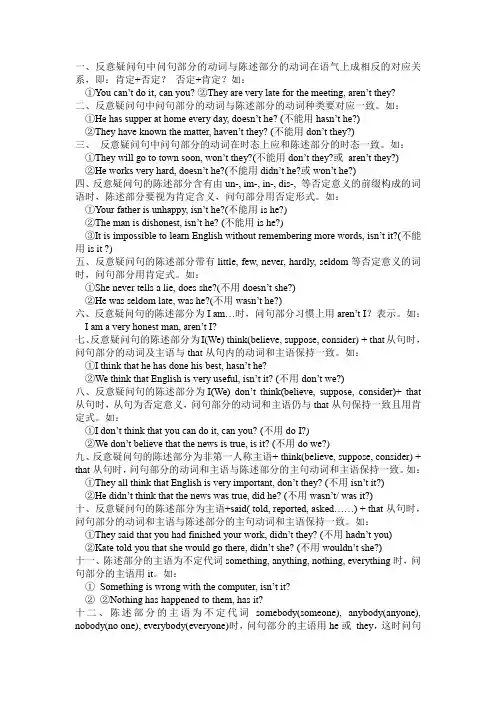
一、反意疑问句中问句部分的动词与陈述部分的动词在语气上成相反的对应关系,即:肯定+否定?否定+肯定?如:①You can’t do it, can you? ②They are very late for the meeting, aren’t they?二、反意疑问句中问句部分的动词与陈述部分的动词种类要对应一致。
如:①He has supper at home every day, doesn’t he? (不能用hasn’t he?)②They have known th e matter, haven’t they? (不能用don’t they?)三、反意疑问句中问句部分的动词在时态上应和陈述部分的时态一致。
如:①They will go to town soon, won’t they?(不能用don’t they?或aren’t they?)②He works very hard, doesn’t he?(不能用didn’t he?或won’t he?)四、反意疑问句的陈述部分含有由un-, im-, in-, dis-, 等否定意义的前缀构成的词语时,陈述部分要视为肯定含义,问句部分用否定形式。
如:①Your father is unhappy, isn’t he?(不能用is he?)②The man is dishonest, isn’t he? (不能用is he?)③It is impossible to learn English without remembering more words, isn’t it?(不能用is it ?)五、反意疑问句的陈述部分带有little, few, never, hardly, seldom等否定意义的词时,问句部分用肯定式。
如:①She never tells a lie, does she?(不用doesn’t she?)②He was seldom late, was he?(不用wasn’t he?)六、反意疑问句的陈述部分为I am…时,问句部分习惯上用aren’t I?表示。
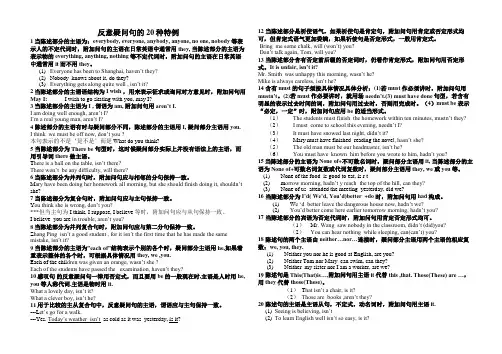
反意疑问句的20种特例1当陈述部分的主语为:everybody, everyone, anybody, anyone, no one, nobody等表示人的不定代词时,附加问句的主语在日常英语中通常用they, 当陈述部分的主语为表示物的everything, anything, nothing等不定代词时,附加问句的主语在日常英语中通常用it而不用they。
(1)Everyone has been to Shanghai, haven’t they?(2)Nobody knows about it, do they?(3)Everything gets along quite well , isn’t it?2当陈述部分的主谓语结构为I wish ,用来表示征求或询问对方意见时,附加问句用May I: I wish to go skating with you, may I?3当陈述部分的主语为I , 谓语为am, 附加问句用aren’t I.I am doing well enough, aren’t I?I’m a real young man, aren’t I?4 陈述部分的主语有时与疑问部分不同,陈述部分的主语用I, 疑问部分主语用you.I think we must be off now, don’t you ?本句表示的不是‘是不是’而是What do you think?5 当陈述部分为There be 句型时,这时候疑问部分实际上并没有语法上的主语,而用引导词there 做主语。
T here is a ball on the table, isn’t there?There won’t be any difficulty, will there?6当陈述部分为并列句时,附加问句应与相邻的分句保持一致。
M ary have been doing her homework all morning, but she should finish doing it, shouldn’t she?7 当陈述部分为复合句时,附加问句应与主句保持一致。
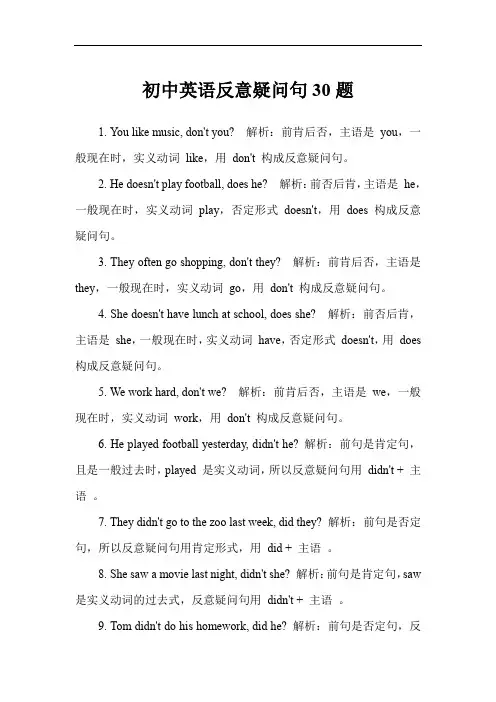
初中英语反意疑问句30题1. You like music, don't you? 解析:前肯后否,主语是you,一般现在时,实义动词like,用don't 构成反意疑问句。
2. He doesn't play football, does he? 解析:前否后肯,主语是he,一般现在时,实义动词play,否定形式doesn't,用does 构成反意疑问句。
3. They often go shopping, don't they? 解析:前肯后否,主语是they,一般现在时,实义动词go,用don't 构成反意疑问句。
4. She doesn't have lunch at school, does she? 解析:前否后肯,主语是she,一般现在时,实义动词have,否定形式doesn't,用does 构成反意疑问句。
5. We work hard, don't we? 解析:前肯后否,主语是we,一般现在时,实义动词work,用don't 构成反意疑问句。
6. He played football yesterday, didn't he? 解析:前句是肯定句,且是一般过去时,played 是实义动词,所以反意疑问句用didn't + 主语。
7. They didn't go to the zoo last week, did they? 解析:前句是否定句,所以反意疑问句用肯定形式,用did + 主语。
8. She saw a movie last night, didn't she? 解析:前句是肯定句,saw 是实义动词的过去式,反意疑问句用didn't + 主语。
9. Tom didn't do his homework, did he? 解析:前句是否定句,反意疑问句用肯定形式did + 主语。
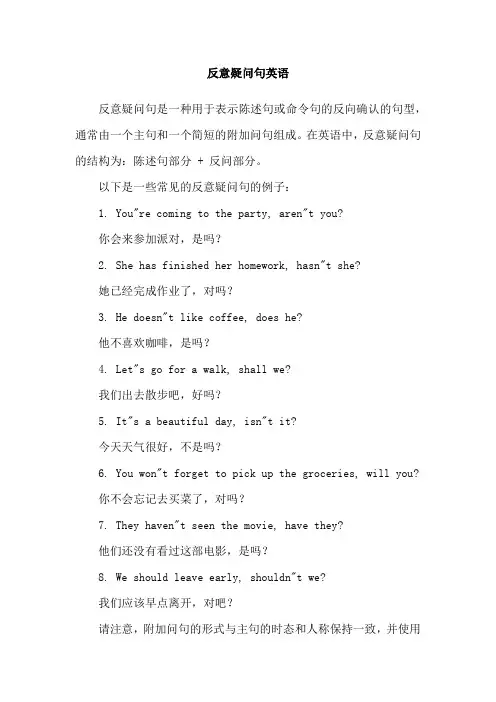
反意疑问句英语
反意疑问句是一种用于表示陈述句或命令句的反向确认的句型,通常由一个主句和一个简短的附加问句组成。
在英语中,反意疑问句的结构为:陈述句部分 + 反问部分。
以下是一些常见的反意疑问句的例子:
1. You"re coming to the party, aren"t you?
你会来参加派对,是吗?
2. She has finished her homework, hasn"t she?
她已经完成作业了,对吗?
3. He doesn"t like coffee, does he?
他不喜欢咖啡,是吗?
4. Let"s go for a walk, shall we?
我们出去散步吧,好吗?
5. It"s a beautiful day, isn"t it?
今天天气很好,不是吗?
6. You won"t forget to pick up the groceries, will you?
你不会忘记去买菜了,对吗?
7. They haven"t seen the movie, have they?
他们还没有看过这部电影,是吗?
8. We should leave early, shouldn"t we?
我们应该早点离开,对吧?
请注意,附加问句的形式与主句的时态和人称保持一致,并使用
相反的助动词或情态动词。
反意疑问句的目的是征求对方的确认或得到进一步的信息。
在口语和书面英语中,反意疑问句经常被使用,以便与对话对象建立更好的交流和理解。
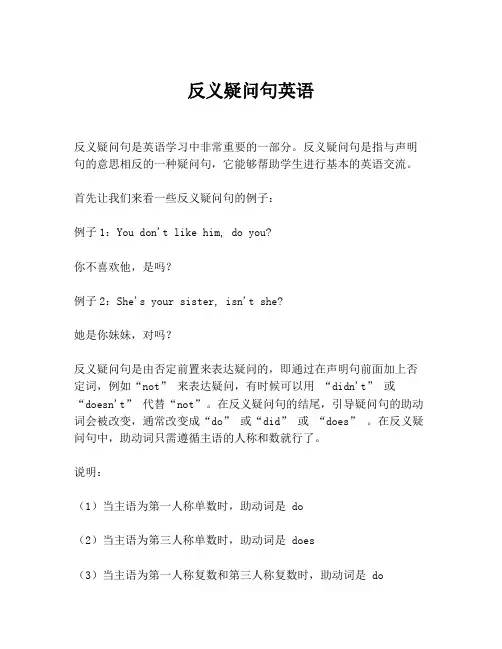
反义疑问句英语反义疑问句是英语学习中非常重要的一部分。
反义疑问句是指与声明句的意思相反的一种疑问句,它能够帮助学生进行基本的英语交流。
首先让我们来看一些反义疑问句的例子:例子1:You don't like him, do you?你不喜欢他,是吗?例子2:She's your sister, isn't she?她是你妹妹,对吗?反义疑问句是由否定前置来表达疑问的,即通过在声明句前面加上否定词,例如“not” 来表达疑问,有时候可以用“didn't” 或“doesn't” 代替“not”。
在反义疑问句的结尾,引导疑问句的助动词会被改变,通常改变成“do” 或“did” 或“does” 。
在反义疑问句中,助动词只需遵循主语的人称和数就行了。
说明:(1)当主语为第一人称单数时,助动词是 do(2)当主语为第三人称单数时,助动词是 does(3)当主语为第一人称复数和第三人称复数时,助动词是 do同时,如果要表达过去否定疑问句,助动词会变成did,所以上面例子1可以改成:You didn't like him, did you?此外,如果要表达虚拟否定疑问句(即虚拟情况的否定疑问句),也可以使用would而不是do来表达。
例如:You wouldn't want to go, would you?你不想去,是吗?至此,我们已经学习了反义疑问句的构成,生活中也可以运用反义疑问句,例如:A:I think you should stay at home tonight.我认为你今晚应该待在家里。
B: But I want to go out and have some fun.但是我想出去玩一下。
A: You don't want to stay at home, do you?你不想呆在家里,是吗?从上文中可以看出,反义疑问句不仅可以让学生掌握基本的英语交流技巧,而且在日常生活中也可以用到,这也是反义疑问句所吸引人的地方。
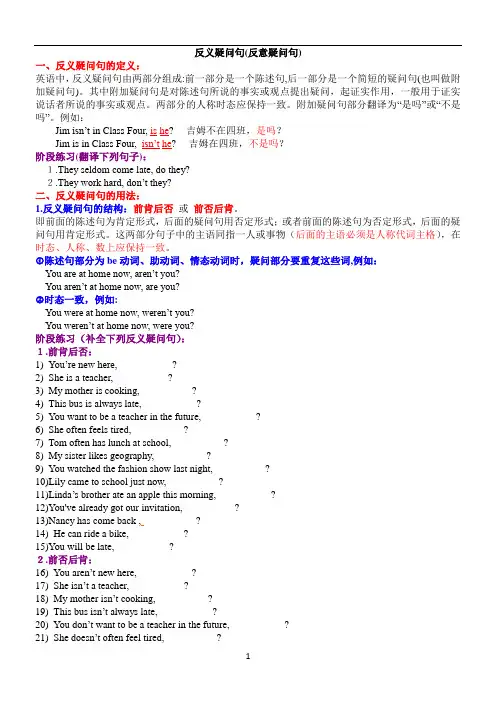
反义疑问句(反意疑问句)一、反义疑问句的定义:英语中,反义疑问句由两部分组成:前一部分是一个陈述句,后一部分是一个简短的疑问句(也叫做附加疑问句)。
其中附加疑问句是对陈述句所说的事实或观点提出疑问,起证实作用,一般用于证实说话者所说的事实或观点。
两部分的人称时态应保持一致。
附加疑问句部分翻译为“是吗”或“不是吗”。
例如:Jim isn’t in Class Four, is he? 吉姆不在四班,是吗?Jim is in Class Four, isn’t he? 吉姆在四班,不是吗?阶段练习(翻译下列句子):1.They seldom come late, do they?2.They work hard, don’t they?二、反义疑问句的用法:1.反义疑问句的结构:前肯后否或前否后肯。
即前面的陈述句为肯定形式,后面的疑问句用否定形式;或者前面的陈述句为否定形式,后面的疑问句用肯定形式。
这两部分句子中的主语同指一人或事物(后面的主语必须是人称代词主格),在时态、人称、数上应保持一致。
①陈述句部分为be动词、助动词、情态动词时,疑问部分要重复这些词,例如:Yo u are at home now, aren’t you?You aren’t at home now, are you?②时态一致,例如:You were at home now, weren’t you?You weren’t at home now, were you?阶段练习(补全下列反义疑问句):1.前肯后否:1) You’re new here, _____ _____?2) She is a teacher, _____ _____?3) My mother is cooking,_____ _____?4) This bus is always late, _____ _____?5) You want to be a teacher in the future, _____ _____?6) She often feels tired,_____ _____?7) Tom often has lunch at school,_____ _____?8) My sister likes geography,_____ _____?9) You watched the fashion show last night,_____ _____?10)Lily came to school just now,_____ _____?11)Linda’s brother ate an apple this morning, _____ _____?12)You've already got our invitation,_____ _____?13)Nancy has come back , _____ _____?14) He can ride a bike, _____ _____?15)You will be late, _____ _____?2.前否后肯:16) You aren’t new here, _____ _____?17) She isn’t a teacher, _____ _____?18) My mother isn’t cooking,_____ _____?19) This bus isn’t always late, _____ _____?20) You don’t want to be a teacher in the future, _____ _____?21) She doesn’t often feel tired,_____ _____?22) Tom doesn’t often have lunch at school,_____ _____?23) My sister doesn’t like geography,_____ _____?24)You didn’t watch the fashion show last night,_____ _____?25)Lily didn’t come to school just now,_____ _____?26)Linda’s brother didn’t eat an apple this morning, _____ _____?27)You haven’t already got our invitation,_____ _____?28)Nancy hasn’t come back , _____ _____?29) He can’t ride a bike, _____ _____?30)You won’t be late, _____ _____?三、反意疑问句的回答:反义疑问句结构是一种简略的一般疑问句,所以一般用Yes, No来回答。
英语反意疑问句反意疑问句是一种特殊的疑问句,其结构为:“陈述句+反意疑问句的转折连接词+反义疑问句”,用于表示对某一观点的质疑或确认。
下面是关于英语反意疑问句的相关内容。
一、反意疑问句的概述反意疑问句是用于询问或肯定对方对陈述的观点的一种问句。
其结构为“陈述句+反意疑问句的转折连接词+反义疑问句”。
反意疑问句的转折连接词有常用的有"but"、"though"、"yet"、"still"等。
反意疑问句一般用于英语口语中,使得对话更加自然流畅。
二、反意疑问句的用法1. 反面认同:对一个肯定的事实提出质疑。
例如:"You went to the party last night, didn't you?"2. 正面疑问:对一个否定的事实提出确认。
例如:"You don't like coffee, do you?"3. 意见确认:对对方的意见进行确认。
例如:"You think it's going to rain today, don't you?"4. 邀请确认:表示邀请的疑问。
例如:"Let's go for a walk, shall we?"三、反意疑问句的语气反意疑问句的语气可以根据情境和语调来调整。
积极的反意疑问句用于表示请求或请求对方的肯定回答,例如:"You'll help me, won't you?" 消极的反意疑问句用于表示期待否定回答或表示对方的斥责,例如:"You didn't do your homework again, didyou?"四、反意疑问句的注意事项1. 反意疑问句通常是在对话中使用,不适用于正式文体。
反意疑问句的答语反意疑问句是一种常见的英语句型,一般由主句和一个含有助动词和否定词的疑问句构成,用于表示询问对方是否同意或确认所述内容。
在交际中,常常需要用到反意疑问句来表示自己的态度或确认对方的理解。
下面是一些反意疑问句及其可能的答语,供大家参考。
1. You don’t mind if I leave early, do you?No, of course not.Yes, I do mind.2. That was a great movie, wasn’t it?Yes, it was!No, I didn’t like it.3. He’s a good teacher, isn’t he?Yes, he is.No, I don’t think so.4. He doesn’t speak Spanish, does he?No, he doesn’t.Yes, he does.5. She won’t be late, will she?No, she won’t.Yes, she might be.6. You’re going to the party tonight, aren’t you?Yes, I am.No, I’m not.7. We could use some help, couldn’t we?Yes, that would be great.No, we can manage.8. It’s a lovely day, isn’t it?Yes, it is.No, I’m not sure I agree.9. You’ve never been to Italy, have you?No, I haven’t.Yes, I have.10. They’re not very good at basketball, are they?No, they’re not.Yes, they’re pretty good.11. She doesn’t eat meat, does she?No, she doesn’t.Yes, she does.12. You haven’t forgotten your passport, have you?No, I haven’t.Yes, I’m afraid I have.13. We don’t need to hurry, do we?No, we don’t.Yes, we should hurry.14. He won’t mind if we borrow his car, will he?No, he won’t.Yes, he might.15. You don’t think it’s going to rain, do you?No, I don’t.Yes, I think it might.以上是一些常见的反意疑问句及其可能的答案,在实际应用中还需要根据具体情况进行调整和组合。
英语中反意疑问句的几种特殊情况说明在英语中,反意疑问句有以下几种特殊情况:1.当陈述部分no ,never ,hardly ,little ,few 等含有否定意义的词时简略句用否定形式,例如:The little boy can hardly speak ,can he ?2.陈述句的主语为名词或代词,简略问句的主语为相应的人称代词;陈述句的主语为指示代词this ,that ,不定代词something ,nothing 等,不定式,动名词或从句时,简略问句的主语为it;陈述句的主语为指示代词these ,those 不定代词everyone,nobody ,everyone等时,简略问句的主语为they ;陈述句为there be 句型时,简略问句中重复使用there 。
To see is to believe ,isn’t it ?There will be a meeting tomorrow ,won’t there ?3.陈述部分是复合句时,简略问句的主语与助动词和主句一致。
例如:She lived in Beijing when she was young ,didn’t she ?但如果主句的谓语动词是think , suppose ,believe ,imagine ,expect ,feel等,且主语为第一人称或第二人称时,简略问句的主语和时态却要和宾语从句一致,而肯定和否定,则要与主句一致。
例如: I don’t think you are a student , are you ?4.祈使句也可加简略问句,不表示反意,只表示语气。
否定祈使句+ will you ?肯定祈使句+ won’t you ?(表示邀请)—1—肯定祈使句+ will you ?(表示请求)Let’t (包括对方)+ …,shall we ?(表示建议)Let us (不包括对方)+ …,will you ?(表示请求)Let +第三人称+ …,will you ?—2—。
英语反意疑问句LEKIBM standardization office【IBM5AB- LEKIBMK08- LEKIBM2C】英语反意疑问句1.一般用法:He is a student, isn't he?He isn't a student, is he?(1) “have to, had better, used to”要用下列方式反问:He has to finishthe work, doesn't heThey used to smoke, didn't / usedn't theyYou'd better get up immediately, hadn't you(2) “has, have”作为助动词和实意动词,反问形式不同。
We have done all the work, haven't weYou have some time, don't you2.“seldom, barely, hardly, scarcely, few, little”语意本身是否定,因此反意问句应为肯定形式。
She seldom comes to visit us, does sheHe hardly knew it, did he3.当主句为祈使句,反意问句提出要求,命令应用“will you”Do it at once, will you?但如表示邀请,劝告,反意问句用“won't you”Have a cup of tea, won't you?4.否定祈使句应用“will you”来反问。
Don't open the window, will you?5.“Let's”短语●当其为肯定形式,“shall we”提出反问Let's play basketball, shall we?●当其为否定形式,“all right, ok”提出反问Let's not go to the party, all right?●如为“let us ...”其反问形式应为“will you”提出请求Let us go home, will you?6.当“think, suppose, consider, believe” etc 被用作为主句谓语动词,其后带有宾语从句时,反意疑问问句应与从句保持一致。
英语中的反义疑问句及其回答1. Positive Statement with Negative Question Tag: Statement: You like pizza, don't you?Reply: Yes, I do.2. Negative Statement with Positive Question Tag: Statement: He doesn't speak Spanish, does he? Reply: No, he doesn't.3. Positive Statement with Positive Question Tag: Statement: She is a doctor, isn't she?Reply: Yes, she is.4. Negative Statement with Negative Question Tag: Statement: They aren't coming, are they?Reply: No, they aren't.5. Positive Imperative Statement with Negative Question Tag:Statement: Let's go to the cinema, shall we?Reply: Yes, let's.6. Negative Imperative Statement with Positive Question Tag:Statement: Don't be late, will you?Reply: No, I won't.7. Positive Statement with Positive Question Tag Using Auxiliary Verb "do":Statement: You eat fish, don't you?Reply: Yes, I do.8. Negative Statement with Negative Question Tag Using Auxiliary Verb "do":Statement: They don't study French, do they?Reply: No, they don't.9. Positive Statement with Positive Question Tag Using Auxiliary Verb "be":Statement: She is happy, isn't she?Reply: Yes, she is.10. Negative Statement with Negative Question Tag Using Auxiliary Verb "be":Statement: He isn't a teacher, is he?Reply: No, he isn't.。
英语反意疑问句1.一般用法:He is a student, isn't he?He isn't a student, is he(1) “have to, had better, used to”要用下列方式反问:He has to finish the work, doesn't he?They used to smoke, didn't / usedn't they?You'd better get up immediately, hadn't you(2) “has, have”作为助动词和实意动词,反问形式不同。
We have done all the work, haven't we?You have some time, don't you2.“seldom, barely, hardly, scarcely, few, little”语意本身是否定,因此反意问句应为肯定形式。
She seldom comes to visit us, does she?He hardly knew it, did he3.当主句为祈使句,反意问句提出要求,命令应用“will you”Do it at once, will you?但如表示邀请,劝告,反意问句用“won't you”Have a cup of tea, won't you4.否定祈使句应用“will you”来反问。
Don't open the window, will you5.“Let's”短语●当其为肯定形式,“shall we”提出反问Let's play basketball, shall we●当其为否定形式,“all right, ok”提出反问Let's not go to the party, all right●如为“let us ...”其反问形式应为“will you”提出请求Let us go home, will you6.当“think, suppose, consider, believe” etc 被用作为主句谓语动词,其后带有宾语从句时,反意疑问问句应与从句保持一致。
I don't think that he is an honest man, is he反意疑问句的意义及其构成反意疑问句又叫附加疑问句,是指当提问的人对前面所叙述的事实不敢肯定,而需要向对方加以证实时所提出的问句.其结构为:前一部分是一个陈述句,后一部分是一个简单的问句.完成后一部分简单问句时,要根据前面陈述句的动词时态和人称来选择适当的助动词进行提问,前后两部分的人称和动词时态要保持一致.如果前一部分用肯定式,后一部分一般用否定式;反之,前一部分为否定式,后一部分要用肯定式,即“前肯定后否定,前否定后肯定”. 例 You have been to Beijing, haven’t you 你去过北京,是吗二、简单句式结构中反意疑问句的运用反意疑问句运用于简单句式结构中时,我们应注意掌握以下几个方面1、当陈述句部分的主语是名词时,反意疑问句的主语必须用人称代词来代替.例 Your brother has gone to the library, hasn’t he 你弟弟去图书馆了,是吗2、当陈述句的主语是指示代词this, that时,反意疑问句的主语用it代替;指示代词是these, those时,反意疑问句的主语用they代替.例 That isn’t a useful book, is it 那不是一本有用的书,是吗These are important reading materials, aren’t they 这些都是重要的阅读材料,是吗3、当陈述句部分是I am…时,反意疑问句部分通常要用aren’t I;如陈述句部分的主语是I am not时,反意疑问句部分通常要用am I.例 I’m late for the meeting, aren’t I 我开会迟到了,是吗 I’m not doing well, amI 我干得不好,是吗4、当陈述部分是everyone / everybody, someone / somebody, no one / nobody, none 等表示人的不定代词时,反意疑问句部分的主语多用they,但也可用he;当陈述部分的主语是everything, anything, something, nothing等表示物的不定代词时,反意疑问句部分的主语用it.例 Nobody came when I was out, did they 我在外时,没人来过,是吗Everything has gone wrong today, hasn’t it 今天什么都出问题了,是不是5、当陈述部分是“there be + 主语 + 其它”结构时,反意疑问部分要用“be (not) + there”结构.例 There are some bananas in the basket, aren’t there 篮子里有些香蕉,是吗6、当陈述部分的谓语动词是have时,有两种情况 .(1)have作“有”解时,反意疑问句部分可用have(not)或do(not)的相应形式.例 His brother has a new bike, hasn’t (doesn’t) he 他弟弟有一辆新自行车,是吗(2)have用作实义动词时,反意疑问句部分只可用do(not)的相应形式.例 We have to start early, don’t we 我们必须早点出发,是吗7、当陈述部分有hardly, scarcely, barely, rarely, seldom, few, little, no, never, nothing, nobody, nowhere等否定词或半否定词时,反意疑问句部分要用肯定形式.注如果陈述句部分是带有否定前缀或后缀时,反意疑问句部分仍用否定结构.例 It’s impossible for him to make such a mistake, isn’t it 他不可能犯这样的错误,是吗8、当陈述部分有情态动词ought to时,反意疑问句部分要用ought / should (oughtn’t / shouldn’t);如陈述部分为情态动词used to,反意疑问部分可用 used或did;如陈述部分为had better,反意疑问部分用hadn’t或shouldn’t.例 Such things ought not to be allowed, ought they 这种事是不允许的,是吗You’d better do it by yourself, hadn’t / shouldn’t you 你最好自己做,好吗9、当陈述句部分有情态动词must时,反意疑问部分有四种情况(1)must表示“必须、禁止“时,反意疑问部分要用must (mustn’t) .例 You mustn’t stop your car here, must you 你不能把车停在这地方,知道吗(2)must表示“有必要”时,反意疑问句部分要用needn’t.例 They must finish the work today, needn’t they 他们今天必须要完成这项工作,是吗(3)当must用来表示对现在的情况进行“推测”时,反意疑问部分要根据must后面的动词采用相应的形式.例 He must be good at maths, isn’t he 他数学一定学得很好,是吗(4)当must用来表示对过去的情况进行“推测”(must + have done)时,如强调对过去情况的推测(一般句中有过去的时间状语),反意疑问句部分要用“didn’t + 主语”;如果强调动作的完成(一般没有过去时间状语),反意疑问句部分要用“haven’t / hasn’t + 主语”.例 She must have read the novel last week, didn’t she 她上星期一定读了这本小说了,是吗You must have told her about it, haven’t you 你一定把这事告诉她了,是吗10、当陈述部分的谓语动词是表示愿望的wish时,反意疑问部分要用may,而且前后两个部分均用肯定式.例 I wish to go to the moon by spaceship some day, may I 我希望总有一天能乘宇宙飞船去月球.11、感叹句的反意疑问句一律使用否定式,并用be的一般现在时形式.例 What a foolish child (he is), isn’t he 多傻的孩子啊,不是吗三、并列分句结构中反意疑问句的运用当陈述句是由并列连接词and, but, or, for, so等连接的两个并列分句组成时,反意疑问句部分一般与最接近的分句保持一致,也就是说,对后一分句进行反问.例 He was a lazy child, and he didn’t pass the exam, did he 他是一个偷懒的孩子,他没能通过考试,是吗四、复合句结构中反意疑问句的运用反意疑问句用于主从复合句结构中时,要注意以下三种情况1.一般情况下,陈述句部分是主从复合句时,反意疑问句部分的代词和助动词应与主句中的主语和动词保持一致.例 This is the second time that he has been to Japan, isn’t it 这是他第二次去日本,是吗2.在宾语从句中,如果陈述句部分是“I think (believe, suppose, imagine, expect等) + 宾语从句”, 反意疑问句部分应与宾语从句的主谓保持一致,并要注意否定转移.例 I don’t think you have heard of him before, have you 我认为你以前没有听说过他,是吗注当think等这些动词的主语不是第一人称,或主语是第一人称,而动词时态不是一般现在时或一般过去时,这时,反意疑问句的助动词和人称代词要与主句保持一致.例 Mary thinks you will come to the party, doesn’t she 玛丽认为你将来参加晚会,是吗3.当陈述句部分为主语从句时,反意疑问句的主语用it.例 That he didn’t pass the entrance exam made his parents very angry, didn’t it 他没有通过入学考试使得他的父母十分生气,是吗五、祈使句结构中反意疑问句的运用祈使句反意疑问句的构成,必须按其句子结构及讲话人的语气来决定其反意部分,有四种形式.1.祈使句的肯定形式,其反意问句表示“请求”时,通常用will you;表示“邀请、劝说”时,用won’t you.例 Be sure to write to us, will you 一定要给我们写信,好吗(表示“请求”)Come to have dinner with us this evening, won’t you 今晚跟我们一起来吃饭,好吗(表示“邀请”)2.祈使句的否定形式,其反意疑问句通常只用will you构成.例 Don’t smoke in the meeting room, will you 请不要在会议室抽烟,好吗3.变异祈使句,即句首为一呼语,后接第二人称代词引导的一个一般现在时的陈述句,这时,我们应视为无主语的祈使句结构,反意疑问句部分要用will you构成.例 Mike, you take all these tables out of the next room, will you 迈克,你把这些桌子都搬出隔壁房间,好吗4. Let开头的祈使句,构成反意疑问句时,除Let’s用shall we构成反意疑问句外,其它均用will you.例 Let the boy go first, will you 让那男孩先走,好吗Let’s take a walk after supper, shall we 晚饭后,我们去散步,好吗六、反意疑问句的回答对反意疑问句的回答,无论问题的提法如何,如果事实是肯定的,就用yes,事实是否定的,就要用no.要特别注意陈述句部分是否定结构,反意疑问句部分用肯定式提问时,回答yes或no 与汉语正好相反.这种省略回答的yes要译成“不”,no要译成“是”.例 ---He likes playing football, doesn’t he 他喜欢踢足球,是吗---Yes, he does. / No, he doesn’t. 是的./ 不是.---His sister didn’t attend the meeting, did she 他妹妹没有参加会议,是吗---Yes, she did. / No, she didn’t. 不,她参加了./ 是的,她没参加1、什么是反意疑问句英语中,反意疑问句是由陈述句和附在其后的附加疑问句组成.其中附加疑问句是对陈述句所说的事实或观点提出疑问,起证实作用,一般用于证实说话者所说的事实或观点.2、反意疑问句用法说明◇注意:反意疑问句前后两部分谓语应是,“肯定陈述+否定疑问”或“否定陈述+肯定疑问”简略问句如果是否定式,not应与be,do,will等系动词、助动词、情态动词缩写简略问句的主语不用名词,应用人称代词当说话者的目的不在疑问,而是为了加强语气时,用降调当说话者的目的在疑问,则用升调陈述部分含“too...to”时,是否定句1) 陈述部分的主语是I,疑问部分要用 aren't I.I'm as tall as your sister,aren't I?(我和你姐姐一样高,对吗)2) 陈述部分的谓语是wish,疑问部分要用may +主语.I wish to have a word with you, may I?(我希望可以和你说话,可以吗)3) 陈述部分用 no, nothing, nobody, never, few, seldom, hardly, rarely, little等否定含义的词时,疑问部分用肯定含义.The Swede made no answer, did he / she?Some plants never blown (开花), do they ?4) 含有ought to 的反意疑问句,陈述部分是肯定的,疑问部分用shouldn't / oughtn't +主语.正式文体用should/ought +主语+not形式.He ought to know what to do, oughtn't he / shouldn't he?5) 陈述部分有have to +v. (had to + v.),疑问部分常用don't +主语(didn't +主语). We have to get there at eight tomorrow, don't we?6) 陈述部分的谓语是used to 时,疑问部分用didn't +主语或 usedn't +主语.He used to take pictures there, didn't he / usedn't he?7) 陈述部分有had better + v. 疑问句部分用hadn't you?You'd better read it by yourself, hadn't you?8) 陈述部分有would rather +v.,疑问部分多用 wouldn't +主语.He would rather read it ten times than recite it, wouldn't he?9) 陈述部分有You'd like to +v. 疑问部分用wouldn't +主语.You'd like to go with me, wouldn't you?10) 陈述部分有must 的疑问句,疑问部分根据实际情况而定.A.must表示“应该”,其疑问部分用mustn't(不应该),如:You must work hard next term, mustn't you 下学期你应该努力学习,对吗B.must表示“必须”,其疑问部分用needn't(不必),如:They must finish the work today, needn’t they 他们今天必须要完成这项工作,是吗?C.陈述部分含情态动词mustn't,表示禁止时,疑问部分就可以用must或may,如:You mustn’t stop your car here, must you (may we)你不能把车停在这地方,知道吗D.must表示推测 ,其疑问部分必须与must 后面的主要动词相呼应.如:①对现在动作或存在的情况的推测:You must know the answer to the exercise, don't you 你一定知道这项练习的答案,是不是That must be your bed, isn't it 那一定是你的床,是吗②对过去发生的动作或存在的情况的推测:a 表示肯定推测(一)句中陈述部分没有表示过去的时间状语,这时疑问部分中的动词就用现在完成时.(haven’t / hasn’t + 主语)v1.0 可编辑可修改You must have told her about it, haven’t you 你一定把这事告诉她了,是吗?(二)陈述部分有表示过去的时间状语,疑问部分的动词就用一般过去时.(didn’t + 主语)She must have read the novel last week, didn’t she 她上星期一定读了这本小说了,是吗b 表示否定推测表示推测时,否定式通常不是must not,而是can't (cannot).如:He can't have been to your home; he doesn't know your address, does he他不可能去过你家;他不知道你的地址,是不是11) 感叹句中,疑问部分用be +主语.What colours, aren't they?What a smell, isn't it?12) 陈述部分由neither… nor, either… or 连接的并列主语时,疑问部分根据其实际逻辑意义而定.Neither you nor I am engineer, are we?13) 陈述部分主语是指示代词或不定代词everything, that, nothing, this, 疑问部分主语用it.Everything is ready, isn't it?14) 陈述部分为主语从句或并列复合句a. 并列复合句疑问部分,谓语动词根据邻近从句的谓语而定.Mr. Smith had been to Beijing for several times, he should have been in China now, shouldn't he?b. 带有定语从句,宾语从句的主从复合句,疑问部分谓语根据主句的谓语而定:He is not the man who gave us a talk, is he?He said he wanted to visit Japan, didn't he?c. 上述部分主句谓语是think, believe, expect, suppose, imagine等引导的宾语从句,疑问部分与宾语从句相对应构成反意疑问句.I don't think he is bright, is he?We believe she can do it better, can't she?但此时主语必须是第一人称如果不是则不能否定从句如 He thought they were wrong,didn't he?而不能说weren't they?15) 陈述部分主语是不定代词everybody, anyone, somebody, nobody, no one等,疑问部分常用复数they,有时也用单数he.Everyone knows the answer, don't they (does he)Nobody knows about it, do they (does he)16) 带情态动词dare或need的反意疑问句,疑问部分常用 need (dare ) +主语.We need not do it again, need we ?He dare not say so, dare you/he?当dare, need 为实义动词时,疑问部分用助动词do + 主语.She doesn't dare to go home alone, does she?17) 省去主语的祈使句的反意疑问句,疑问部分用will you.Don't do that again, will you?Go with me, will you / won't you ?注意: Let's 开头的祈使句,后用shall we(或用shan't we) ?Let us 开头的祈使句,后用will you(或won't you)?Let's go and listen to the music, shall we(或用shan't we)?Let us wait for you in the reading-room, will you (或won't you)?18) 陈述部分是"there be"结构的,疑问部分用there省略主语代词.There is something wrong with your watch, isn't there?There will not be any trouble, will there?19) 否定前缀不能视为否定词,其反意疑问句仍用否定形式.It is impossible, isn't it?He is not unkind to his classmates, is he20)当主句是由so引起的一个句子,而且译为“这么说来”时,疑问部分的谓语形式(肯定或否定)应与主句保持一致.So you have seen the film, have you?So he has not been to Beijing ,hasn't he『补:Let's和Let us的区别』◇'s是Let us的缩写.包括说话人和听话人双方在内,含有催促、建议或请对方一起行动的意思.在听话人表示赞同建议时可只用Let's.如:---Shall we go by train?---Yes,let's.◇2.当请求对方允许自己(第一人称复数)做某事时,要用Let us,这里的 us 不包括听话对方在内,不能缩写为Let's.如两个同学对老师说:Please let us remove the bookshelf for you.让我俩给你移动一下书架.◇3.两者在构成附加疑问句时,方法不同.如:Let's go to see the film,shall we ?咱们去看电影,好吗?Let us go to see the film,will you?让我们去看电影,好吗?快速记忆表陈述部分的谓语疑问部分I aren't IWish may +主语no,nothing,nobody,never,few, seldom, hardly, 肯定含义rarely, little等否定含义的词ought to(肯定的) shouldn't/ oughtn't +主语have to+v.(had to+v.) don't +主语(didn't +主语) used to didn't +主语或 usedn't +主语had better + v. hadn't youwould rather + v. wouldn't +主语you'd like to + v. wouldn't +主语must 根据实际情况而定感叹句中 be +主语Neither…nor,either…or 连接的根据其实际逻辑意义而定并列主语指示代词或不定代词everything,that, 主语用itnothing,this并列复合句谓语根据邻近从句的谓语而定定语从句,宾语从句的主从复合句根据主句的谓语而定think,believe,expect,suppose,imagine等引导与宾语从句相对应的从句everybody,anyone,somebody,nobody,no one 复数they, 单数he情态动词dare或need need (dare ) +主语dare, need 为实义动词 do +主语省去主语的祈使句 will you/won't you/can't you Let's 开头的祈使句 Shall weLet us 开头的祈使句 Will youthere be 相应的谓语动词+there(省略主语代词)否定前缀不能视为否定词仍用否定形式must表"推测" 根据其推测的情况来确定反意疑问句反意疑问句的回答对反意疑问句的回答,无论问题的提法如何,如果事实是肯定的,就用yes,事实是否定的,就要用no.要特别注意陈述句部分是否定结构,反意疑问句部分用肯定式提问时,回答yes或no 与汉语正好相反.这种省略回答的yes要译成“不”,no要译成“是”.例 ---He likes playing football, doesn’t he 他喜欢踢足球,不是吗?---Yes, he does. / No, he doesn’t. ,是他喜欢./ 不他不喜欢.---His sister didn’t attend the meeting, did she 他妹妹没有参加会议,是吗?---Yes, she did. / No, she didn’t. 不,她参加了./ 是的,她没参加若be动词后是never意疑问句通常由两部分构成:前一部分用陈述句的形式(statement),后一部分是一个附着在前一部分上的简短问句(也叫tag question).所附简短问句中的主语和谓语与陈述句的保持一致,而且两部分的时态要一致.反意疑问句有四种类型:(1)肯定陈述+否定简短问句;(2)否定陈述+肯定简短问句;(3)肯定陈述+肯定简短问句;(4)否定陈述+否定简短问句.其中,前两种运用最为广泛.除此之外,反意疑问句还有“祈使句+简短问句”的形式,这种用法通常用于减弱祈使语气.如: Carry this parcel for me, can you 给我拿一下包,好吗?反意疑问句的构成有以下几点特殊情况须注意:1.当陈述句的主语是everyone, everybody, someone, somebody时,简短问句中的主语通常用they.如果陈述句的主语是非人称的复合词,如everything, something, anything, 则简短问句中相应的人称代词是单数的中性词it.例如:Somebody borrowed my coat yesterday, didn’t they?Nobody came, did they?Everyone thinks they’re the center of the universe, don’t they?Nothing can stop us now, can it?2.当陈述句是表示存在的句子时,简短问句用there 作形式主语.例如:There isn’t a book on the table, is there?There’s something wrong, isn’t there?There won’t be any trouble, will there?3.如果陈述句中包含有如下的否定或半否定词, 如seldom, hardly, never, rarely,little, few, nowhere, nothing,则简短问句通常用肯定形式.但如果陈述句中仅包含有否定前缀,则简短问句中用否定形式.例如:He was unsuccessful, wasn’t he?The rules are invariable, aren’t they?He seldom pays more attention to his pronunciation, does he?He hardly knows anything about computer, does he?Tom has little knowledge of how to spend money, does he?4.陈述句中是I am时,简短问句则用aren’t I.例如:I am an excellent English speaker, aren’t I?I am late, aren’t I ?5.陈述句中是非限定人称代词one时,正式文体中,简短问句的主语为one,而非正式文体中用you.例如:One must be honest, mustn’t one?6.含有宾语从句的主从复合句的反意疑问句中,简短问句一般反映主句中主、谓之间的关系.但如果主句是I think, I suppose, I believe, I suspect, I imagine 等时,则简短问句反映的是that从句中主语与谓语之间的关系.例如:They agreed that the United States shouldn’t make a war on Iraq, didn’t they?I suppose (that) he is serious, isn’t he?注意:否定词移位的情况,如:I don’t suppose (that) he is serious, is he?7.如果陈述句的谓语动词是have (当“拥有”讲时), 简短问句可用have形式或用do 形式.例如:You have a nice house, haven’t/don’t you?但如果陈述句是否定形式时,简短问句中动词的选择则由陈述句中的动词形式而定.例如:He hasn’t a house of his own, has heHe doesn’t have a house of his own, does he?如果陈述句中的动词 have 表示“经历,遭受,得到,吃”的意思时,则简短问句中的动词用do的形式.例如:You often have headaches, don’t you?8.当陈述句的动词是ought to时,英国英语中简短问句用ought,而美国英语中则用should.9.陈述句中的动词是used to时,简短问句可用used 的形式或did的形式.例如:The Smiths used to live in the countryside, usedn’t / didn’t they?He didn’t use/used to tell lies, did he?10.陈述句中动词为needn’t时,简短问句通常用 need.例如:You needn’t do it if you don’t want to, need you?You needn’t have told him the news, need you?11.陈述句中must后动词的类属和时态不同,反意疑问句也不同.例如:The food must be good, isn’t it?You must have read the book last month, didn't you?You must see the doctor, needn’t you(must表必要性,故用needn’t)You mustn’t do that again, must you(must表示“不可以”)12.当陈述部分是一祈使句时,简短问句则通常为 won’t you, would you, can you, can’t you, could you等,使语气婉转、客气.如果陈述部分的祈使句中含有第一人称时,如Let’s do something, 则简短问句为 shall we例如:Do sit down, won’t youShut up, can you?在否定的祈使句后, 只能用will you.例如:Don’t forget, will you13.当遇到宾语从句时候.一般反主句.但是以 I think I believe. Isuppose .开头的反从句二、中文中的反意疑问句简称反问句,是句式中的一种.表面上看,是疑问句;实际上说话者是在强调某种肯定或否定的答案,也就是明知故问.这类句式常和“难道”、“怎么”等词联接.通常答案就在句子当中. 比如:1. "难道我会不知道"----说话者是在强调自己是知道的.2. "(难道)我有这么笨吗"----说话者在强调自己并不笨.这里“难道”一词也可以省略.3."数学真的这么难么"----说话者在强调数学不难.4."那怎么是一样的呢"----说话者在强调那是不一样的.5.我们难道要浪费时间吗——强调要珍惜时间6.你们怎能破坏环境呢——强调要保护环境7.不是应该这样的吗——强调应该这样反问句结尾时正常用问号,而有些特殊的句子也可一用感叹号.如:“得把他们抱过来,同死人待在一起怎么行!”意思就是说同死人待在一起不行,表示极度强调.同英文中不同,回答这类问题往往是按照个人习惯如:“数学真的这么难么”答:“不是,数学很简单.”问:“那怎么是一样的呢”答:“是啊,那明明不一样.”[编辑本段]英语18种特殊的反意疑问句1.祈使句.祈使句后一般加上will you或won't you构成反意疑问句,用will you 多表示“请求”,用won't you 多表示提醒对方注意.例如:Look at the blackboard, will you/ won't you看黑板,好吗?Let引导的祈使句有两种情况:1)Let's...,后的反意疑问句用shall we或shan't we.例如:Let's go home, shall we/ shan't we 回家吧,好吗?还可以用may I来表示征求对方的同意或许可.2)Let us/me...后的反意疑问句用will you或won't you.例如:Let me have a try, will you/won't you 让我试一试,行吗?2.感叹句.感叹句后加反意疑问句时,其反意疑问句需用be的一般现在时态的否定形式.例如:What fine weather, isn't it 多好的天气啊,是吧?3. 当陈述部分谓语动词是need, dare, used to,且这些词被用作实义动词时,其反意疑问句需用do的适当形式.例如:He needs help, doesn't he他需要帮助,是吗?4.陈述部分主、谓语是I am...时,反意疑问句用aren't I 或ain't I ,而不是am not I (可用am I not).例如:I'm working now, ain't I 我在工作,是吗?5.陈述部分的主语是everything, nothing, anything或something 时,反意疑问句的主语应用代词it.例如:Something is wrong with my radio, isn't it 我的收音机出毛病了,是吧?6.陈述部分的主语是 everybody, everyone, anybody, anyone, somebody, someone, nobody, no one, none, neither 时, 其反意疑问句的主语需用复数代词they.例如:Everyone is here, aren't they 大家都到了,是吗?No one knows about it, do they 没有人知道这件事,对吗?7.陈述部分的主语是指示代词this或that时,反意疑问句的主语用it,当陈述部分的主语是指示代词these或those时,其反意疑问句的主语用they.例如:This is a plane, isn't it 这是一架飞机,是吗?These are grapes,aren't they 这些是葡萄,是吗?8.陈述部分的主语是不定代词one时,反意疑问句的主语可以用one,也可用you(美式英语用he).例如:One should be ready to help others, shouldn't one 每个人都应该乐于助人,是吧?9.当陈述部分含有以下这些含有否定意义的词时:few, little, seldom,hardly, never, not, no, no one, nobody, nothing, none, neither等,其反意疑问句需用肯定结构.例如:He is never late for school, is he 他上学从不迟到,是吗?10.当陈述部分所含的否定词是通过加前缀或后缀构成的,其后的反意疑问句依然用否定结构.例如:It is unfair, isn't it 这不公平,是吧?11.含有否定含义的词在陈述部分作动词的宾语时,其反意疑问句用肯定结构,也可以用否定结构.例如:You got nothing from him, did you 你从他那儿什么也没得到,是吗?12.当陈述部分主语是从句、不定式(短语)、动词-ing形式时,反意疑问句的主语应该用it.例如:What you need is more important, isn't it你需要的东西更重要,是吧?13.当陈述部分含I think (believe, suppose...)that... 结构时,其反意疑问句须与从句的主、谓语保持一致,注意主句的主语必须是第一人称.例如:I don't think he will come, will he 我认为他不会来,对吗?(has)不是表示“有”的意思,并在句中做谓语时,其反意疑问句的助动词要用do, does, did.例如:They had a meeting just now,didn't they 他们刚才开了个会,是吗?15.陈述部分有have to 时,其反意疑问句要用助动词的否定形式.例如:You have to water the vegetables every day, don't you你每天都要浇菜,对吧?16.陈述部分是there be句型时,其反意疑问句中要用there.例如:There was a hospital here, wasn't there 过去这儿有家医院,是吗?17.陈述部分有had better时,反意疑问句中要用hadn't.例如:We had better go to school at once, hadn't we 我们现在最好马上去上学,好吗?18.当陈述部分含有情态动词must时,我们便要分析一下must的含义.如果must 作“一定;要;必须”讲,反意疑问句须用mustn't或needn't;而当must作推测意义“一定是;必定”讲时,反意疑问句则需根据must后的动词原形选用相应的形式.例如:。